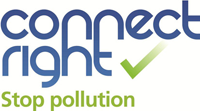Misconnected sewers
Plumbing and drainage misconnections pollute rivers and beaches throughout the UK. Check your property is connected right. If wastewater or sewage is connected to a surface water drain you may be polluting your local river or beach.
As a property owner you're responsible for fixing a misconnection. Contact Dŵr Cymru, your local authority or a WaterSafe plumber.
If you suspect you have a misconnected property or have noticed a pollution incident taking place, please contact us on (0800 0853968) or pollutionrisk@dwrcymru.com
The ConnectRight campaign aims to:
Prevent misconnections and raise awareness about drainage and water pollution amongst property owners, the public and professionals. It brings together partners who are working to reduce water pollution - environmental regulators, water companies, local authorities and other professional and interested organisations.
Misconnections matter – the facts
1. Two types of drainage system exist:
- combined where all flows go to foul sewer and are treated at a sewage works
- separate where clean rainfall drains directly to river, sea or ground, and foul sewage drains to a sewage treatment plant
2. Two types of misconnection exist
- sewage or waste water are connected to clean surface water drains
- clean water is connected to foul drains
Our concern is mostly with the former:
3. Misconnections cause pollution. Foul discharges to clean water drains result in untreated sewage going directly to a watercourse. But clean rainfall to foul is also a problem as it causes sewerage overflows, takes up sewer capacity, affects sewage treatment plants and takes energy to pump and treat.
4. Almost all urban streams are affected to some extent. It is estimated that 15% of our rivers and 9% (that’s 49 beaches) are failing water quality standards due to misconnections and sewer related pollution.
5. Sewage pollution has five main polluting effects:
- nutrients, especially Phosphorus, cause excessive plant growth and then lead to oxygen depletion with die back; they alter the natural ecology and kill fish and other wildlife
- pathogens are a health risk and may affect shellfisheries
- organic matter when digested by bacteria and other microbes results in oxygen levels being depleted killing fish and other wildlife
- toxins – increasing evidence shows that chemicals like Nonylphenols, washed out of imported clothing, and Tryclosan, an anti bacterial agent in hand washes, toothpaste and many other products are affecting watercourses. The long term effect of these substances on wildlife is not yet clearly understood.
- aesthetic impacts – sewage derived debris and ‘solids’
6. Half of UK homes are on separate sewers. The exact number with misconnections is difficult to estimate due to the complexity of the housing stock. The UK Water Industry report suggests around 140,000 properties but in some areas investigations have found up to 1 in 5 properties misconnected. The real UK total could be more than 500,000.
7. Property conversions, the DIY culture, ignorance of sewers amongst the public and building trade all add to the problem. The most common misconnections are washing machines (35%), sinks (10-15%), dishwashers (10-15%), toilets (5%), whole houses (5%).
8. Water companies, Natural Resources Wales and the Environment Agency, with support from local authorities, are working to address the problem locally and nationally. Costs of investigation are high. Water companies are spending more and more finding misconnections in sewer networks; current estimates to investigate and find all misconnections put the figure at as much as £450 million and to correct the drainage £42 million.
9. The connectright.org.uk website has a facility for checking for misconnections and more information on misconnections and sewer related pollution.
10. ‘UK PLC’ has to comply with meeting water quality standards under certain European Directives. We can all play our part in protecting our local environment.



